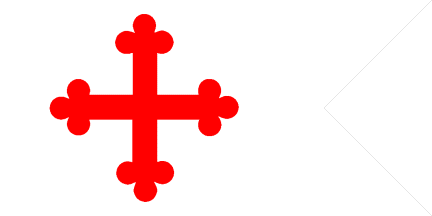
Last modified: 2006-04-15 by antonio martins
Keywords: sucre | coat of arms (border) | jerusalem cross | cross: jerusalem | cross: pommely (red) |
Links: FOTW homepage |
search |
disclaimer and copyright |
write us |
mirrors

It seems that it is “something”
on white as can be seen in the photo at
this location.
Dov Gutterman, 26 Jun 2001
.gif)
The original
image includes also the legend "YNSYGNE E MVI NOBLE E MVI
LEAL CIVDAD DE LA PLATA" around the top of the shield. I do
not know wheather this is considered part of the coat of arms, nor
whaether it is included in the flag.
António Martins, 09 May 2004
This coat of arms is the first one given to a city in
present day Bolivia. It was originally given to the
City of La Plata (first name of present day City of
Sucre) in 1559 (in the coat of arms you can see the
two-headed imperial eagle used mostly during the
times of Emperor Charles V, and
something during Philip II reign). One of the mountains in
the coat of arms is the Potosí Hill. The ten
“things” around the coat of arms, are
decapitated heads.
Francisco Gregoric, 23 Nov 2005

Depicted in the arms of Sucre, Bolivia, there is a 1:2 white flag with
a square trangle cut-out from the fly (a stubby swallowtail) with a red
cross centered on the remaining area; the cross seems to be bottony or
pommelly.
António Martins, 21 Nov 2005
The Cross of that flag (in the coat of arms) is defined in
Bolivia as the Cross of Jerusalem. So that white flag with
red cross could have been originally related to the
Christian faith. However it is
different from the [yellow] Cross of Jerusalem
[or red]
we usually know.
Francisco Gregoric, 23 Nov 2005
The Cross of Jerusalem we usually know is a
cross potent crosslet, though the
crosslets seem to have been lost in copying while the potent ("T"-like)
endings of the arms were misshaped.
António Martins, 27 Nov 2005